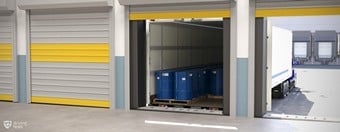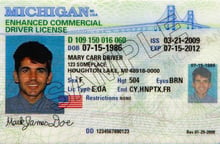

All your missed questions are saved
automatically for extra practice.




It's a practice test that's automatically made up of all your missed questions. Once you finish this test, you’ll be able to revisit your Challenge Bank™ to practice and sharpen your skills.
View All PlansAdding difficult questions to Challenge Bank™ is an exclusive Premium feature. Unlock access to 650+ exam-like questions, a Pass Guarantee, personalized study plans, and more.
View All PlansFree Michigan HazMat (H) Endorsement Practice Test 2026
| 90-100 | => | 23% |
| 80-89 | => | 28% |
| 70-79 | => | 24% |
| 60-69 | => | 14% |
| <60% | => | 10% |
Michigan offers HazMat drivers a wide range of opportunities—and challenges. Major routes like I-75, I-94, and I-96 connect Detroit’s automotive giants to chemical plants across the state. From winter snows to the forested Upper Peninsula with its sparse infrastructure, driving here demands skill. But the rewards are significant when you add the Hazardous Materials (HazMat) endorsement to your CDL.
Why get HazMat certified in Michigan? You gain access to specialized, higher-paying jobs transporting petroleum products, industrial chemicals, automotive chemicals, agricultural chemicals, and explosives (for construction and mining). Without this endorsement, these opportunities are completely off-limits—you cannot legally transport any materials classified as hazardous by the U.S. government.
Top Michigan employers requiring HazMat drivers:
- Ford Motor Company (Dearborn)
- General Motors (Detroit)
- Stellantis (Auburn Hills)
- Marathon Petroleum (Detroit)
- Dow Chemical (Midland)
- BASF (Wyandotte)
What to expect on the official Michigan HazMat test:
- Questions: 30 multiple-choice
- Passing score: 80% (24 correct)
- TSA background check: Required (allow 2-4 weeks for processing)
- Topics covered: Federal regulations, substance handling, packaging, quantity limits, transport configurations
How to get your HazMat endorsement:


Reviewed for legal and handbook accuracy
M.S., Chief Educational Researcher (ACES member)
Last verified for accuracy on
Real Michigan drivers who passed first try
Verified student reviews • Shared with permission
About the Michigan CDL
- Start TSA fingerprinting immediately—results take weeks
- Study while you wait using our practice tests and the official CDL manual (Michigan CDL Handbook 2026)
- Pass the SOS knowledge test
- Visit SOS with documents, pay fees, and receive your endorsement
Our Michigan HazMat practice tests mirror the official exam format and provide immediate feedback on every question. No unnecessary information – just what you need to pass on your first try.
More MI CDL test resources
Are you in another state?
- Alabama
- Alaska
- Arizona
- Arkansas
- California
- Colorado
- Connecticut
- Delaware
- District of Columbia
- Florida
- Georgia
- Hawaii
- Idaho
- Illinois
- Indiana
- Iowa
- Kansas
- Kentucky
- Louisiana
- Maine
- Maryland
- Massachusetts
- Michigan
- Minnesota
- Mississippi
- Missouri
- Montana
- Nebraska
- Nevada
- New Hampshire
- New Jersey
- New Mexico
- New York
- North Carolina
- North Dakota
- Ohio
- Oklahoma
- Oregon
- Pennsylvania
- Rhode Island
- South Carolina
- South Dakota
- Tennessee
- Texas
- Utah
- Vermont
- Virginia
- Washington
- West Virginia
- Wisconsin
- Wyoming
We know what it takes to pass. And we’ve got the proof.
Driver’s Ed is - nobody wants to set foot inside the SOS. That’s why millions of learners trust us for simple, visual, effective prep.
An official & trusted partner in driver education
We are an officially recognized FMCSA Entry-Level Driver Training provider and a proud partner to over 2,500 libraries. We work with safety organizations like GHSA and the National Safety Council to help create safer roads for everyone.






A smarter way to study
Challenge Bank™
Our trademarked system automatically saves questions you miss, creating personalized tests that target your weak spots until you’ve mastered the material.
AI-powered feedback
Get smarter as you study. Our new AI-powered feedback provides detailed, question-level insights to help you understand the why behind each answer.
Interactive handbook
Go beyond the boring black-and-white manual. Our interactive handbook lets you read, listen with an MP3 audio version, or even chat with it to find the information you need, faster.
We build our practice questions from the current 2026 MI Driver Handbook and refine them using patterns recent test‑takers report.
Driver handbook • Knowledge‑test/permit overview • Fees & ID requirements • Office/appointment info
We mirror recurring themes (e.g., right‑of‑way traps, sign look‑alikes) and use similar distractors and wording styles.
We don’t collect or publish actual test items and we’re not affiliated with SOS.

